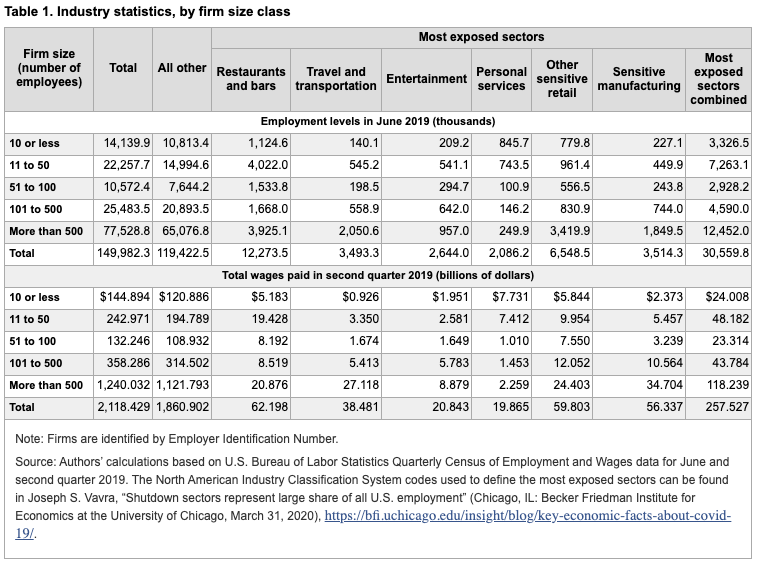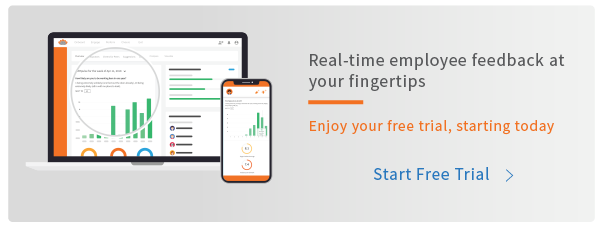It’s been a rocky road for employee engagement as a result of the COVID-19 pandemic.
COVID’s impact has been felt not only in the daily lives of millions of employees, but in society as a whole. Now, it’s more important than ever for employers to find ways to maintain a strong connection with employees so they can be productive and stick with their jobs, which have new and unexpected challenges.
During a crisis, how exactly can employers promote employee engagement to retain a strong workforce? Let’s take a look.
Employee Engagement and the Remote Employee
In April 2020, the U.S. Bureau of Labor Statistics reported that more than 20 percent of employees were ”immediately affected by the COVID-19 shutdowns.”
This created a crisis for many workers who suddenly found themselves without suitable work. Making matters worse, many had to wait long periods of time for unemployment benefits to kick in.
Those who had the capability to work remotely to protect their health did so. But they, too, had sacrifices to make in terms of making suitable childcare arrangements, setting up a home office with the right equipment, and adjusting to life in quarantine, among other things.

These factors combined, it’s no wonder employees feel disengaged and worried about the future of their careers. In the meantime, more than half the workforce remains remote until the pandemic subsides and a vaccine is available.
Add it all up, and employers must ask themselves, “Does employee engagement mean something new in light of what everyone has just experienced?” In other words, the way employers go about measuring and monitoring employee engagement requires a fresh approach.
HR’s Role as Crisis Manager
One of the major aspects that nearly all human resource professionals agree on is that — during a crisis the size of the pandemic — they are tasked with being the crisis managers of their organizations.
Check out this recent TINYtalk to see what this transformation has meant for Altek Supply, an oil and gas supplier based in Canada:
It’s important that managers work with human resources to understand the symptoms of poor employee engagement. These can include:
- A general lack of interest including communication
- Poor attendance at remote meetings
- A negative attitude about work and towards others
- Conflicts with coworkers and clients
- Zero follow-through on projects
- No enthusiasm for work at all
Use Employee Surveys to Make Data-Driven Decisions During a Crisis
Fortunately, HR can intervene early in the crisis management portion of an event. They just need to have the right insights and tools needed to help facilitate positive changes.
For example, the TINYpulse COVID-19 survey was designed to help organizations see where they could best support their employees. The questions were created to understand the most crucial needs of employees and determine whether any additional intervention or resources were needed to help employees make the transition to working from home.
The survey entails a series of questions that employees are requested to grade on a scale of 1 to 5 that indicates how much they agree with the following statements:
- I feel my organization has done a great job with internal communication regarding the Coronavirus/COVID-19.
- I have everything I need to do my job while working from home.
- I feel that I am as productive working from home as I am in my normal working environment.
- I feel highly connected to my team as we work remotely.
- I have the right amount of virtual contact with my colleagues on a weekly basis.
- What else do you need to help you work remotely more effectively? (e.g., desk, chair, monitor, headphones, etc.)
- I don't feel anxious about the future of our organization.
- I don't feel concerned about losing my job.
- I have regular, productive 1-on-1 sessions with my manager.
- I have safe channels to share any concerns regarding Coronavirus/COVID-19 or its impact.
- Overall, I am satisfied with my organization’s response to the Coronavirus/COVID-19 situation.
- What are your top two concerns or suggestions (if any) that you would like us to consider to get through the COVID-19 situation?
The data provided by this survey has enabled human resource managers to have a better idea of how employees were coping during the pandemic — including the changing dynamics of each team and employee relationships with management. Having this data has proven to be critical for helping make decisions about what to do next and whether employees were still feeling engaged with the organization.
The Challenges of Engaging Remote Workers
There are a number of challenges you’ll run into while trying to engage remote employees.
For starters, it can be difficult to determine if a remote employee is engaged in their work when it’s impossible to observe them in person. Your best bet is to note their participation and enthusiasm. Communication can play a huge role in this, too.
Sometimes, HR and management think that things are going well because they don't hear any complaints from remote workers. But it’s a mistake to think that things are okay because you haven’t heard otherwise. Maybe employees are being quiet because they don't feel comfortable talking about their concerns due to trust issues. Or maybe they’ve already become disengaged.
Remote workers often struggle with feeling isolated and left out of team activities and updates — to the point where it can feel intentional. Working onsite offers the advantage of being around peers daily and having conversations about projects. Remote workers don’t get this same experience. But if you wanted to keep them engaged, you also need to loop them in with their manager and teammates and give them regular updates and internal communication technology so they feel connected to work.
How Can I Promote Remote Employee Engagement in the Middle of a Crisis?
Human resources professionals can facilitate greater employee engagement in remote workers in a number of ways. When you have the overall perspective of what’s happening currently and what’s to come, a strategy for maintaining employee engagement in a crisis can be formed.
With that in mind, here’s a rundown of 10 ways HR can promote employee engagement in the middle of any crisis.
1. Use transparent communication
According to our recent survey, “research highlights it’s vital to be as transparent as possible about the impact to the company and their [employees] jobs.”
In terms of employee engagement, remote workers need to know what is happening and what the impact may be on them professionally. HR can increase transparency by opening up safe communication channels and sending out frequent updates on what’s occurring.
2. Update your remote processes
Organizations should have SOPs created for dealing with any crisis that could take employees away from their normal work environment. This includes standards for remote work success.
Keep in mind that the processes should also factor in care for employees on multiple levels so that they remain productive and engaged. For example, more support for working parents who have kids at home, expanded wellness and healthcare resources, and home office setup support can all make your employees feel more engaged.
3. Improve team connectivity
With all the current technology that we have now, staying connected as a team is fairly seamless. The real challenge is the learning curve and change of routine that many employees have to adjust to when migrating to virtual meetings and digital project management tools.
The good news is that most people are pretty accustomed to using emails, virtual meetings, and open dialogue platforms to stay connected. This is also a good place for human resources to communicate with employees and keep people uplifted—such as sharing lighthearted humor and news about positive things that are happening in the company.
HR can also facilitate training and open forums for all employees to participate in, so they regain their confidence and engagement.
4. Use an employee survey
During COVID-19, the employee engagement survey has become even more important. Using pulse surveys and other flexible surveys to gather feedback from employees in real time is vital to managing people wherever they happen to work.

With the right tools in place, surveys can be launched in very little time across the entire company so that all employees can participate. Use employee surveys to crowdsource ideas for team-building activities or show your commitment to team diversity with a TINYpulse diversity and inclusion survey template.
5. Improve onboarding and coaching
Remote work can be lonely, especially for anyone who onboards during a crisis like the pandemic.
In addition to the overwhelming nature of starting a new job and getting oriented to a new set of processes, onboarding as a remote worker has unique challenges. These can include: a lack of team connection, confusion over training and technology, and struggling to relate to the corporate culture, among other things.
According to our research, the more engaged employees are during the first days, the more likely they are to remain engaged thereafter. Asking the right onboarding questions can help determine if a new hire feels welcomed and supported during this crucial time.
Creating the habit of consistent 1-on-1 meetings is the perfect opportunity to build trust with employees early on, as well as spot any obstacles. Tools like TINYpulse Coach can also help managers know how to best support their team.
6. Break things up with non-work sessions
Non-work sessions are just as important to employee engagement as work sessions. Events outside of the office are a great opportunity for people to be themselves.
One example of this is Step Up For Students, a nonprofit organization that is focused on school choice in the state of Florida. The organization that very often starts virtual meetings with ice-breaker games or just has fun coffee hours where people can chat about what’s on their minds.
It’s important for employees to get to know each other outside of work-related matters to build stronger teams and reduce any tension or conflict. The more people know about each other, the more they can relate and appreciate each person’s unique value.
7. Consider using the phone vs. Zoom
Using virtual meetings is okay in most cases. However, with more people reporting “Zoom exhaustion.” HR should encourage employees to pick up the phone more often to connect with one another. Let managers hold their one-on-one’s on the phone to engage with employees in a non-threatening or distracting way.
With many more people working from home, fatigue and burnout must be kept in check. To do this, HR can encourage employees to keep regular hours and avoid working too much due to poor time management or pressure from others. This includes employees who live in varying time zones.
HR can also educate employees about creating work-life balance. Self-care and taking regular time off can also prevent fatigue and make it easier to reach your full potential.
8. Focus on goal setting
To maintain employee engagement, learn your employees’ career goals and focus on them. Think about what has changed about each employee’s role and how the company can support new reasonable goals — even if they are temporary for the time being. A great area to consider is professional development, which can be useful no matter what the future brings.
Another big part of engagement is communicating company goals on a regular basis to align employees with the direction the company is heading. Show employees how they can make an impact on company goals while achieving their professional growth.
For example, what skills has the employee not tapped into? How can they translate to a new client project or an idea for an improvement?
9. Recognize and promote your best
One of the biggest hurdles that remote workers face is their tendency to feel invisible within the organization. They are easily passed over by in-house or more communicative employees for promotions and they may get very little recognition.
Solve this by encouraging remote employees to toot their own horn, so to speak, and share their successes. Managers can regularly recognize and promote remote employees who are deserving of this honor.
Peers can contribute to this, too. Giving shout-outs for a job well done and making these compliments public can go a long way towards fostering employee engagement and positivity.
10. Tie employee efforts to the future
Employees are often worried about their future with the company for two reasons.
One, they are afraid that their efforts will not be seen or appreciated. Two, they may find themselves without a job if the company does not perform well.
In order to keep employees engaged, it is important that you tie their efforts directly to what happens in the immediate future.
Ready to Increase Employee Engagement?
HR can help increase employee engagement by promoting a deep understanding and empathy for remote workers. While engaging employees during a crisis, remember they have many of the same concerns you have about their well-being and future career.
Employee surveys are a great way to listen to employees in a non-threatening way. However, listening is not enough. You also need to be conscious about the questions you are asking, proactive in addressing the feedback and concerns, and willing to continue the conversation to come up with a reasonable solution.
TINYpulse surveys can be helpful when it comes to increasing communication and providing employees with a safe outlet for expressing their more pressing concerns as we navigate the next phase of work. To learn more about how TINYpulse can help your organization keep your remote workforce engaged in any circumstance, request a demo today.
Related: 6 Proven Methods for Bringing Company Values to Life

